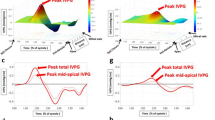Abstract
To evaluate the long-term effects of anthracyclines on the myocardium of the young child we examined 34 patients who had been treated with anthracyclines in childhood. In addition to anthracycline, the patients were treated with other potentially cardiotoxic substances within the framework of different protocols. The mean cumulative anthracycline dose was 128.6 mg/m2 the average age at onset of chemotherapy 4.2 years, and the time interval after discontinuation of treatment 9.0 years. The cardiological examination consisted of a physical examination, electrocardiography and echocardiography, including Doppler and bio-impedance cardiography. The patients were studied at rest and after physical exercise with a cycle ergometer test in a supine position. The results of the physical examination, the electrocardiogram at rest and the 24 h Holter monitoring were normal. The left ventricular enddiastolic diameter, shortening fraction, velocity of fibre shortening (VCF), the diastolic flow profile at the mitral valve level and the cardiac stroke volume at rest were also normal. However, the shortening fraction (SF) was below the margin of 2 standard deviations in two patients and the VCF in three patients. There was a significant reduction in septal thickness, (−1.4 SD,P<0.0004), in the width of left ventricular posterior wall (−1.5 SD,P>0.0002) and in the left ventricular myocardial mass (−0.76 SD,P=0.0042). Physical working capacity was normal. Immediately after physical stress the expected rise of SF and VCF did not occur and the SF fell below the values at rest. In comparison to a healthy control group the SF and the VCF were markedly decreased (P>0.0001). The stroke volume decreased by 14% compared to the pre-exercise value.
Conclusion
Chemotherapy with anthracyclines even in low dosages, results in myocardial damage, which does not however, effect physical capacity over a long penod but which is revealed by reduced left ventricular wall thickness and myocardial mass. Functional effects include insufficient increase of SF, VCF and stroke volume during physical exercise.
Similar content being viewed by others
Abbreviations
- IVS :
-
inter ventricular septum
- LVEDD :
-
left ventricular endiastolic dimension
- LVPW :
-
left ventricular posterior wall
- QTc :
-
corrected QT-interval
- SF :
-
shortening fraction
- VCF :
-
velocity of circumferential fibre shortening
References
Bazzett HC (1920) Analysis of the time relation of ECG. Heart 7:353–369
Colan SD, Parness IA, Spevak PJ, Sanders SP (1992) Developmental modulation of myocardial mechanics: age- and growth-related alterations in afterload and contractility. J Am Coll Cardiol 19:619–629
Colan DC (1992) Assessment of ventricular and myocardial performance. In: Fyler DC (ed) Nadas' pediatric cardiology. Hanley and Belfus, Philadelphia, p. 229
Daniels R, Meyer RA, Liaug Y, Bove KE (1988) Echocardiographically determined left ventricular mass index in normal children, adolescents and young adults. J Am Coll Cardiol 12: 703–708
Devereux R, Reichek N (1977) Echocardiographic determination of left ventricular mass in man: anatomic validation of the method. Circulation 55:613–618
Freter CE, Lee TC, Billingham ME, Chak L, Bristow MR (1986) Doxorubicin cardiac toxicity manifesting seven years after treatment. Am J Cardiol 80:483–485
Goorin AM, Chauvenet AR, Prez-Atayde AR, Cruz J, McKone R, Lipshultz SE (1990) Initial congestive heart failure, six to ten years after doxorubicin chemotherapy for childhood cancer. J Pediatr 116:144–147
Gottlieb S, Edmiston A, Haywood L (1980) Late doxorubicin cardiotoxicity. Chest 78:880–882
Grossman W, Jones D, Mclaurin LP (1975) Wall stress and patterns of hypertrophy in the human left ventricle. J Clin Invest 56:56–64
Hausdorf G, Morf G, Erttmann R, Winkler K, Landbeck G, Keck EW (1988) Long term doxorubicin cardiotoxicity in childhood: non-invasive evaluation of the contractile state and diastolic filling. Br Heart J 60:309–315
Kantrowitz NE, Bristow MR (1984) Cardiotoxicity of antitumor agents. Prog Cardiovasc Dis 27:195–199
Kubicek WG, Karnegis JN, Patterson RP, Witsoe DA, Mattson RH (1966). Development and evaluation of an impedance cardiac output system. Aerospace Med 37:1208–1212
Lange L, Fabecic-Sabadi V, Bein G (1983) Vergleichende Übersicht echocardiographischer Normalwerte vom Frühgeborenen bis zum Adoleszenten. Herz 8:105–121
Lipshultz SE, Colan SD, Gelber RD, Perez-Atayde AR, Sallan SE, Sanders SP (1991) Late cardiac effects of doxorubicin therapy for acute lymphoblastic leukemia in childhood. N Engl J Med 324:808–815
Oyen EM, Ingnatzy K, Ingerfeld G, Brode P (1987) Echocardiographic evaluation of left ventricular reserve in normal children during supine bicycle exercise. Int J Cardiol 14:145–154
Snider AR, Gidding S, Rocchini A, Rosenthal a, Dick M, Crowley D, Peters J (1985) Doppler evaluation of the left ventricular diastolic filling in children with systemic hypertension. Am J Cardiol 56:921–926
Stefadouros MA, Dougherty MS, Grossman W, Craige E (1973) Determination of systemic vascular resistance by noninvasive technique. Circulation 47:101–107
Steinherz LJ, Steinherz PG, Tan CTC, Heller G, Murphy ML (1991) Cardiac toxicity 4 to 20 years after completing anthracycline therapy. J Am Med Assoc 266:1672–1677
Yeung ST, Yoong C, Spink J, Galbraith A, Smith PJ (1991) Functional myocardial impairment in children with anthracyclines for cancer. Lancet 337:816–818
Author information
Authors and Affiliations
Rights and permissions
About this article
Cite this article
Lang, D., Hilger, F., Binswanger, J. et al. Late effects of anthracycline therapy in childhood in relation to the function of the heart at rest and under physical stress. Eur J Pediatr 154, 340–345 (1995). https://doi.org/10.1007/BF02072099
Received:
Accepted:
Issue Date:
DOI: https://doi.org/10.1007/BF02072099




